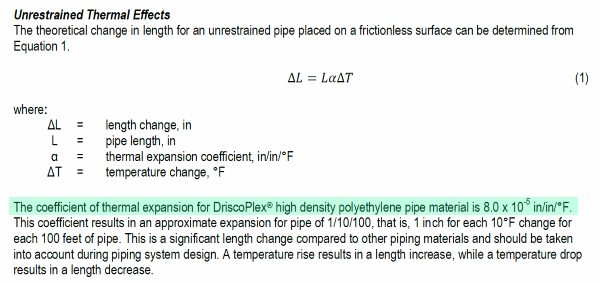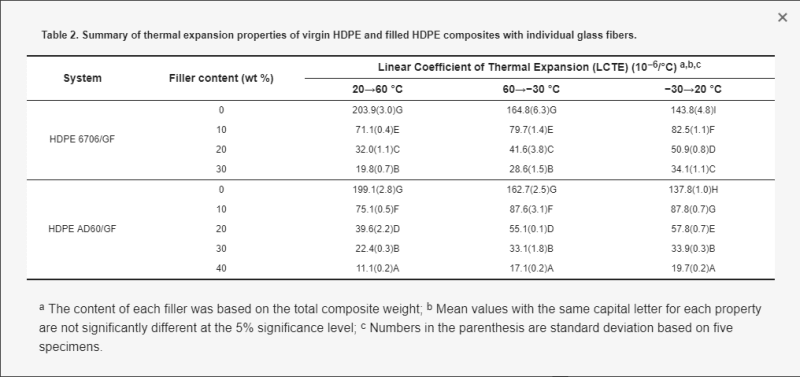Navigation
Install the app
How to install the app on iOS
Follow along with the video below to see how to install our site as a web app on your home screen.
Note: This feature may not be available in some browsers.
More options
Style variation
-
Congratulations TugboatEng on being selected by the Eng-Tips community for having the most helpful posts in the forums last week. Way to Go!
You are using an out of date browser. It may not display this or other websites correctly.
You should upgrade or use an alternative browser.
You should upgrade or use an alternative browser.
Thermal expansion coefficient HDPE (PE 100) at -2.2°F 1
- Thread starter drakkkko
- Start date
- Status
- Not open for further replies.
-
1
- #2
SlideRuleEra
Structural
From DriscoPlex Technical Note PP 814-TN, Engineering Considerations:
DriscoPlex brand includes PE100:

Normal use includes subfreezing temperatures:

Thermal Expansion:

![[idea] [idea] [idea]](/data/assets/smilies/idea.gif)
DriscoPlex brand includes PE100:

Normal use includes subfreezing temperatures:

Thermal Expansion:

![[idea] [idea] [idea]](/data/assets/smilies/idea.gif)
racookpe1978
Nuclear
Yes, but "sub-freezing" is "expected to be" less than freezing (32 def F to perhaps 18 or 20 degrees F) by most writers.
Isn't it an entirely different condition for plastics at "below zero" conditions?
In other words, FIRST check that the plastic will actually perform as needed (expansion, contraction, flex, leakage, bending, shock) for actual pressures and fluid and temperature at -5 degrees to -10 degrees F. Then consider whether that plastic will expand or contract enough to cause enough stress at the wrong point to crack the stiffer piping at that low a temperature.
I am considering those WWII steel ships that were designed for storms and hurricane-force winds at 70 degrees F, were "okay" at "sub-freezing" temperatures (- 5 deg F) but broke in half at -15 degrees F in the harbor. Unloaded.
Isn't it an entirely different condition for plastics at "below zero" conditions?
In other words, FIRST check that the plastic will actually perform as needed (expansion, contraction, flex, leakage, bending, shock) for actual pressures and fluid and temperature at -5 degrees to -10 degrees F. Then consider whether that plastic will expand or contract enough to cause enough stress at the wrong point to crack the stiffer piping at that low a temperature.
I am considering those WWII steel ships that were designed for storms and hurricane-force winds at 70 degrees F, were "okay" at "sub-freezing" temperatures (- 5 deg F) but broke in half at -15 degrees F in the harbor. Unloaded.
SlideRuleEra
Structural
racookpe1978 said:Isn't it an entirely different condition for plastics at "below zero" conditions?
For typical engineering purposes at the temperature of interest, not for polyethylene and certain other plastics used for piping. One value for thermal coefficient of expansion is considered adequate for the range of temperatures (including below zero) where HDPE is an appropriate material.
The complete answer is in "Thermal Expansion and Contraction in Plastics Piping Systems", PPI TR-21/2001 published by the Plastic Pipe Institute.
Interesting that in a later follow-on question in different forum, the OP disclosed that the pipe is to be buried... making the effective coefficient of thermal expansion more like 0.0 x 10-5 in/in/oF (i.e. zero), because of restraint by soil friction.
![[idea] [idea] [idea]](/data/assets/smilies/idea.gif)
Thermal expansion coefficient tends to decrease with decreasing temperature, so whatever value you got for room temperature will be the upper bound. The graph from shows a fairly substantial slope for HDPE.
See also:
TTFN (ta ta for now)
I can do absolutely anything. I'm an expert! faq731-376 forum1529 Entire Forum list
See also:
TTFN (ta ta for now)
I can do absolutely anything. I'm an expert! faq731-376 forum1529 Entire Forum list
SlideRuleEra
Structural
IRstuff said:The graph from shows a fairly substantial slope for HDPE.
Take a close look at the graph in the link provided. The graph shows "Change In Length" versus "Change in Temperature".
The fact that the lines on the graph are straight means the author of the graph has assumed a constant coefficient of thermal expansion for each material... including HDPE.

![[idea] [idea] [idea]](/data/assets/smilies/idea.gif)
Thanks, but the second link has values at colder temperatures on the order of 140 ppm/K, although it appears as if there's some hysteresis

TTFN (ta ta for now)
I can do absolutely anything. I'm an expert! faq731-376 forum1529 Entire Forum list

TTFN (ta ta for now)
I can do absolutely anything. I'm an expert! faq731-376 forum1529 Entire Forum list
SlideRuleEra
Structural
IRstuff said:Thanks, but the second link has values at colder temperatures on the order of 140 ppm/K, although it appears as if there's some hysteresis
Since a temperature change of 1o Kelvin = a temperature change of 1.8o Fahrenheit, and if my math is right, 140 ppm/K = 7.78 x 10-5 in/in/oF
7.78 x 10-5 in/in/oF is pretty good agreement with the published DriscoPlex value of 8.0 x 10-5 in/in/oF (see excerpt from DriscoPlex literature shown above).
![[idea] [idea] [idea]](/data/assets/smilies/idea.gif)
Sure; the main thing was what was a decent value to use at well below freezing.
TTFN (ta ta for now)
I can do absolutely anything. I'm an expert! faq731-376 forum1529 Entire Forum list
TTFN (ta ta for now)
I can do absolutely anything. I'm an expert! faq731-376 forum1529 Entire Forum list
LittleInch
Petroleum
Drakkkko,
you've issued three posts on the same thing in different forums including this one
It looks like you're trying to lay an HDPE pipeline on the ground and then cover it with gravel? at a depth of about 1m and operate this at a min of -20C / -2 F
Expansion and contraction will vary depending on route and relative temperature compared to laying temperature.
PE pipe is quite slippery, so the length of straight pipe before it "locks up" is probably in the order of 2-300m. The end point of the pipe would then either need anchors to prevent movement or you accept a degree of movement, which with PE is quite high compared to steel pipes.
However you seem to be ignoring the issue of the below freezing temperatures. This will freeze the ground and could easily create frost heave moving the pipe around and doing unknown things to the stress on the line or any adjacent pipelines.
It all looks very bitty and uncertain and if you want help you're best of combining all your posts and explaining what you're looking for help with.
Remember - More details = better answers
Also: If you get a response it's polite to respond to it.
you've issued three posts on the same thing in different forums including this one
It looks like you're trying to lay an HDPE pipeline on the ground and then cover it with gravel? at a depth of about 1m and operate this at a min of -20C / -2 F
Expansion and contraction will vary depending on route and relative temperature compared to laying temperature.
PE pipe is quite slippery, so the length of straight pipe before it "locks up" is probably in the order of 2-300m. The end point of the pipe would then either need anchors to prevent movement or you accept a degree of movement, which with PE is quite high compared to steel pipes.
However you seem to be ignoring the issue of the below freezing temperatures. This will freeze the ground and could easily create frost heave moving the pipe around and doing unknown things to the stress on the line or any adjacent pipelines.
It all looks very bitty and uncertain and if you want help you're best of combining all your posts and explaining what you're looking for help with.
Remember - More details = better answers
Also: If you get a response it's polite to respond to it.
- Thread starter
- #11
LittleInch,
I need to perform the flexibility analysis of the HDPE pipe. This pipeline lay on the ground and has continuous berm over according to the design of other engineers but there are no further details of what this berm will be like. There are no technical specifications, so if I want to change this design, to place supports, I must have a backup.
On the other hand I should not perform HDPE flexibility analysis, but it is required by my boss.
I'm sorry for asking for help in other post but I do not know anything about the berm (I did not even know what the name was in English) and I have not done flexibility analysis before in HDPE pipelines, so naturally I needed advice on what characteristics to take into account HDPE and model it in the Caesar program.
In short what I need is technical criteria to correctly model the HDPE pipeline and the berm that covers it.
Anyway I thank you for the help you have given me.
Best Regards.
I need to perform the flexibility analysis of the HDPE pipe. This pipeline lay on the ground and has continuous berm over according to the design of other engineers but there are no further details of what this berm will be like. There are no technical specifications, so if I want to change this design, to place supports, I must have a backup.
On the other hand I should not perform HDPE flexibility analysis, but it is required by my boss.
I'm sorry for asking for help in other post but I do not know anything about the berm (I did not even know what the name was in English) and I have not done flexibility analysis before in HDPE pipelines, so naturally I needed advice on what characteristics to take into account HDPE and model it in the Caesar program.
In short what I need is technical criteria to correctly model the HDPE pipeline and the berm that covers it.
Anyway I thank you for the help you have given me.
Best Regards.
- Status
- Not open for further replies.
Similar threads
- Locked
- Question
- Replies
- 9
- Views
- 2K
- Replies
- 0
- Views
- 1K
- Locked
- Question
- Replies
- 3
- Views
- 836
- Question
- Replies
- 4
- Views
- 4K
- Question
- Replies
- 2
- Views
- 9K
